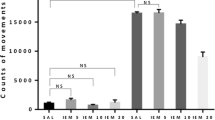Abstract
N-methyl-D-aspartate (NMDA) and non-NMDA receptors were found to be involved in development of functional disorders caused by hexachlorophene. In order to specify the role of glutamate receptors we studied the protective effects of the selective antagonist of the kainate/(±)-α-amino-3-hydroxy-5-methylisoxazole-4-propionic acid (AMPA) receptor/channel 1,2,3,4-tetrahydro-6-nitro-2,3-dioxo-benzo[f]quinoxaline-7-sulphonamide disodium (NBQX) and of the non-competitive NMDA receptor antagonist ifenprodil tartrate on coordinative motor behaviour of adult male Wistar rats as assessed in a simple `ladder-test'. Neurotoxic injury of the cerebrum after hexachlorophene administration and putative amelioration after treatment with test substances was demonstrated histologically. Hexachlorophene-induced motor disturbance remitted spontaneously when stopping the noxis, but remittance occurred significantly earlier when NBQX [0.45 and 0.6 mg/kg intraperitoneal (i.p.)] was applied as well. Ifenprodil (0.15 to 1.2 mg/kg) did not improve the motor function. Vacuolation of white matter of the whole cerebrum was observed after 3 weeks of treatment with hexachlorophene. These morphological alterations caused by hexachlorophene treatment [central nervous system (CNS) vacuolation] spontaneously revert only after 5–6 weeks. The 5-day duration with test substances was too short for remission of vacuolation which thus may not apply to the situation after treatment with glutamate antagonists, despite improvement of motor function. The results suggest that kainate/AMPA receptor channels are at least partially involved in the mechanism of brain damage induced by hexachlorophene, however, the polyamine binding site of the NMDA receptor evidently is not involved.
Similar content being viewed by others
Author information
Authors and Affiliations
Additional information
Received: 14 September 1999 / Accepted: 18 October 1999
Rights and permissions
About this article
Cite this article
Häntzschel, A., Andreas, K. Non-N-methyl-D-aspartate (NMDA) receptor antagonist 1,2,3,4-tetrahydro-6-nitro-2,3-dioxo-benzo(f)quinoxaline-7-sulphonamide (NBQX) decreases functional disorders in cytotoxic brain oedema. Arch Toxicol 73, 581–587 (2000). https://doi.org/10.1007/s002040050011
Issue Date:
DOI: https://doi.org/10.1007/s002040050011



